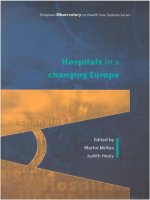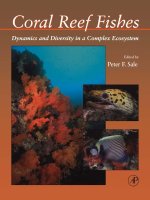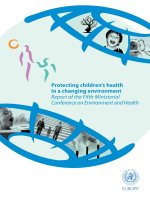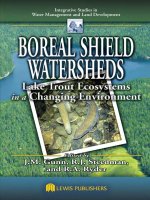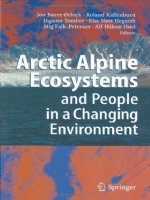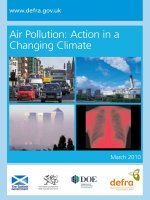Arctic Alpine Ecosystems and People in a Changing Environment pdf
Bạn đang xem bản rút gọn của tài liệu. Xem và tải ngay bản đầy đủ của tài liệu tại đây (5.43 MB, 446 trang )
Jon Børre Ørbæk
Roland Kallenborn
Ingunn Tombre
Else Nøst Hegseth
Stig Falk-Petersen
Alf Håkon Hoel
Arctic Alpine Ecosystems
Arctic Alpine Ecosystems Arctic Alpine Ecosystems
Arctic Alpine Ecosystems
and People in a Changing Environment
and People in a Changing Environmentand People in a Changing Environment
and People in a Changing Environment
Jon Børre Ørbæk
Roland Kallenborn
Ingunn Tombre
Else Nøst Hegseth
Stig Falk-Petersen
Alf Håkon Hoel
Editors
Arctic Alpine Ecosystems
Arctic Alpine Ecosystems Arctic Alpine Ecosystems
Arctic Alpine Ecosystems
and People in a Changing
and People in a Changing and People in a Changing
and People in a Changing
Environment
EnvironmentEnvironment
Environment
with 86 Figures and 10 Tables
Dr. Jon Børre Ørbæk Dr. Else N. Hegseth
Norwegian Polar Institute Norwegian College of Fishery Science
Svalbard University of Tromsø
P.O.Box 505 Breivika
9171 Longyearbyen 9037 Tromsø
Norway Norway
Dr. Roland Kallenborn Dr. Stig Falk-Petersen
Norwegian Institute Norwegian Polar Institute
for Air Research Polar Environmental Centre
Polar Environmental Centre 9296 Tromsø
9296 Tromsø Norway
Norway
Dr. Ingunn Tombre Dr. Alf H. Hoel
Norwegian Institute University of Tromsø
for Nature Research Department of Political Science
Polar Environmental Centre Breivika
9296 Tromsø 9037 Tromsø
Norway Norway
Cover photograph: Bjørn Fossli Johansen, Norwegian Polar Institute, 2005
Library of Congress Control Number: 2006935137
ISBN-10 3-540-48512-4 Springer Berlin Heidelberg New York
ISBN-13 978-3-540-48512-4 Springer Berlin Heidelberg New York
This work is subject to copyright. All rights are reserved, whether the whole or part of the
material is concerned, specifically the rights of translation, reprinting, reuse of
illustrations, recitation, broadcasting, reproduction on microfilm or in any other way, and
storage in data banks. Duplication of this publication or parts thereof is permitted only
under the provisions of the German Copyright Law of September 9, 1965, in its current
version, and permission for use must always be obtained from Springer-Verlag. Violations
are liable to prosecution under the German Copyright Law.
Springer is a part of Springer Science+Business Media
Springer is a part of Springer Science+Business Media Springer is a part of Springer Science+Business Media
Springer is a part of Springer Science+Business Media
springer.com
© Springer-Verlag Berlin Heidelberg 2007
The use of general descriptive names, registered names, trademarks, etc. in this
publication does not imply, even in the absence of a specific statement, that such names
are exempt from the relevant protective laws and regulations and therefore free for
general use.
Cover design: E. Kirchner, Heidelberg
Production: Almas Schimmel
Typesetting: camera-ready by authors
Printing: Krips bv, Meppel
Binding: Stürtz AG, Würzburg
Printed on acid-free paper 30/3141/as 5 4 3 2 1 0
Preface
This book addresses the significant environmental changes experienced by
high latitude and high altitude ecosystems at the beginning of the 21st cen-
tury. Increased temperatures and precipitation, reduction in sea ice and
glacier ice, the increased levels of UV-radiation and the long-range trans-
ported contaminants in arctic and alpine regions are stress factors that
challenge terrestrial and aquatic ecosystems. The large natural variation in
the physical parameters of these extreme environments is a key factor in
structuring the biodiversity and biotic productivity, and the effect of the
new stress factors can be critical for the population structures and the in-
teraction between species. These changes may also have socio-economic
effects if the changes affect the bio-production, which form the basis for
the marine and terrestrial food chains.
The book is uniquely multidisciplinary and provides examples of vari-
ous aspects of contemporary environmental change in arctic and alpine re-
gions. The 21 chapters of the book are organised under the fields of
•Climate change and ecosystem response, •Long range transport of pollut-
ants and ecological impacts, and •UV radiation and biological effects, each
also including aspects of the •Socio-economic effects of environmental
change. The introductory chapter presents and explains the internal con-
nection and integration of all chapters. The added value of these reviews
and review-like manuscripts from different disciplines hopefully yields
new information about the integrated aspects of environmental change.
The chapters are written on the basis of manuscripts presented at the in-
ternational conference on “Arctic Alpine Ecosystems and People in a
Changing Environment”, organized in Tromsø, Norway in February 2003.
The conference was multidisciplinary in scope, aiming at creating new
links and understandings across disciplinary boundaries and among re-
searchers and research infrastructures, inviting the international marine,
terrestrial and atmospheric environmental change research communities to
meet and exchange recent research and monitoring results. The emphasis
was on the European arctic and alpine environments. The conference was
organized as a EURO-CONFERENCE supported by the European Com-
mission. It also served as the final conference of the European Network for
Arctic-Alpine Multidisciplinary Environmental Research (ENVINET), the
final conference of the Nordic Arctic Research Programme (NARP), the
vi Arctic-alpine ecosystems and people in a changing environment
last user meeting of the Ny-Ålesund Large Scale Facility, the first confer-
ence of the Arctic Seas Consortium and the final workshop of the EU-
project UVAC (The influence of UV-radiation and climate conditions on
fish stocks).
The following organizations are acknowledged for their financial sup-
port of the conference and the preparation of this book:
•EUROCONFERENCE: High Level Scientific Conferences, European
Commission IHP-programme, Contract HPCF-CT-2002-00238,
•ENVINET: European Network for Arctic-Alpine Multidisciplinary Envi-
ronmental Research, European Commission IHP-programme, Contract
HPRI-CT-1999-40009. •NARP: Nordic Arctic Research Programme, Nor-
dic Council of Ministers, •Ny-Ålesund LSF: Ny-Ålesund Large Scale Fa-
cility for Arctic Environmental Research, European Commission IHP-
programme, Contract HPRI-CT-1999-00057, •UVAC: The influence of
UV-radiation and climate conditions on fish stocks: A case study of the
north-east Arctic cod, European Commission Environment-programme,
Contract EVK3-CT-1999-00012, •Norwegian Ministry of Environment,
•The University of Tromsø, including the Department of Political Science
and the Norwegian College of Fishery Science, •Institute of Marine Re-
search, Tromsø and the •Polar Environmental Centre, Tromsø, including
the Norwegian Polar Institute, Norwegian Institute for Nature Research
and Norwegian Institute of Air Research.
The editors wish to thank all authors and co-authors for their valuable
set of complementary and multidisciplinary chapters, which together hope-
fully will add value to the reflection of the integrated scientific questions
and environmental challenges faced by arctic-alpine environments. We
would also like to thank the many reviewers that have provided valuable
comments and advice to all manuscripts, as well as Mrs. Ingrid Storhaug
for her very competent assistance in editing this volume.
Tromsø 2005, on behalf of the editors
Jon Børre Ørbæk, Norwegian Polar Institute
Contents
Preface v
Contents vii
Contributors vxii
Abbreviations xxiii
1 Integrated aspects of environmental change: Climate change, UV
radiation and long range transport of pollutants 3
J.B.Ørbæk, R.Kallenborn, I. Tombre, E.N.Hegseth, S.Falk-Petersen and
A.H.Hoel 3
1.1 Introduction 3
1.2 Climate change and ecosystem response 4
1.3 UV radiation and biological effects 8
1.4 Ecological impacts of long range pollutants transport 11
1.5 Integrated aspects 13
1.6 Conclusions 15
Acknowledgements 16
References 16
2 An environment at risk: Arctic indigenous peoples, local livelihoods
and climate change 19
Mark Nuttall 19
2.1 Introduction 19
2.2 Indigenous Peoples and Traditional Livelihoods 20
2.3 Renewable Resource Use and Climate Change: Risk and Access
to Food Resources 23
2.4 Concerns Over Irreversible Impacts 27
2.5 Responding to Climate Change: Flexibility, Adaptation, Barriers
and Opportunities 28
2.6 Conclusions 31
Acknowledgements 33
References 33
3 Climate variation in the European sector of the Arctic: Observations
and scenarios 39
Inger Hanssen-Bauer 39
viii Arctic-alpine ecosystems and people in a changing environment
3.1 Introduction 39
3.2 Observed climate variability in the European Arctic 39
3.2.1 Temperature 39
3.2.2 Precipitation 41
3.2.3 Sea-ice 42
3.2.4 Atmospheric circulation vs. temperature and sea-ice 43
3.2.5 Possible causes for the observed climate variation 44
3.3 Climate scenarios for the European Arctic 45
3.3.1 Temperature 45
3.3.2 Precipitation 46
3.3.3 Other climate variables 47
3.4 Summary and conclusions 47
References 48
4 Impact of climate change on arctic and alpine lakes: Effects on
phenology and community dynamics 51
R. Primicerio, G. Rossetti, P A. Amundsen and A. Klemetsen 51
4.1 Introduction 51
4.2 Plankton 53
4.2.1 Phenology 55
4.2.2 Community dynamics 56
4.3 Benthos 58
4.3.1 Phenology 58
4.3.2 Community dynamics 59
4.4 Fish 59
4.4.1 Phenology 60
4.4.2 Community dynamics 61
4.5 Higher-order effects of climate change and lake communities 63
4.6 Conclusions 64
References 64
5 Changes in growing season in Fennoscandia 1982-1999 71
Kjell Arild Høgda, Stein Rune Karlsen, and Hans Tømmervik 71
5.1 Introduction 71
5.2 Data and Methods 74
5.2.1 Satellite Data 74
5.2.2 Ground Data 74
5.2.3 Growing Season Analysis 75
5.3 Results 76
5.3.1 Onset of Growing Season 76
5.3.2 End of Growing Season 78
5.4 Discussion 80
Contents ix
5.5 Conclusion 82
Acknowledgements 83
References 83
6 Northern climates and woody plant distribution 85
R.M.M. Crawford and C.E. Jeffree 85
6.1 Introduction 85
6.2 Interpreting distribution maps 86
6.3 Mapping species occurrence probability in relation to
temperature 89
6.4 Woody shrub case histories 91
6.4.1 Possible migration anomalies and case histories 91
6.5 Ecological limitations for the survival of woody plants 95
6.6 Physiological disadvantages of warm winters 98
6.7 Conclusions 101
Acknowledgements 102
References 102
7 Topographic complexity and terrestrial biotic response to high-
latitude climate change: Variance is as important as the mean 105
W. Scott Armbruster, David A. Rae, and Mary E. Edwards 105
7.1 Introduction 105
7.2 Variation and climate models 106
7.3 Biotic response to microclimatic variation 107
7.4 Latitudinal Trends in Variation in Radiation Load 108
7.5 Measuring Microclimate and Biotic Response to Variation in
Slope and Aspect 110
7.5.1 Effect of Topography on Seasonal Radiation Sums and
Microclimate 110
7.5.2 Effects of Topography and Microclimate on Composition of
the Biotic Communities and Soil Environment 112
7.5.3 Complex Indirect Effects of Microclimate 114
7.6 Scaling Micro-scale Patterns up to “Real Space” Landscape
Models of Ecosystem Response to Climate Change 115
7.7 Topographically induced variation in UV stress 116
7.8 Conclusions 117
Acknowledgments 117
References 117
8 The flow of Atlantic water to the Nordic Seas and Arctic Ocean 123
Tore Furevik, Cecilie Mauritzen, and Randi Ingvaldsen 123
8.1 Introduction 123
x Arctic-alpine ecosystems and people in a changing environment
8.2 Nordic Seas bathymetry, circulation, and water mass
transformation 125
8.2.1 Bathymetry 125
8.2.2 Circulation 126
8.2.3 Water mass transformation 127
8.3 Observed changes in the Nordic Seas marine climate 132
8.3.1 North Atlantic Oscillation 132
8.3.2 Atlantic inflow 134
8.3.3 Atlantic Water temperatures 136
8.3.4 Intermediate Waters and Overflows 138
8.3.5 Deep Waters 139
8.4 Expected impacts of anthropogenic climate change 140
8.5 Summary and conclusion 141
Acknowledgements 142
References 143
9 Climate variability and possible effects on arctic food chains: The
role of Calanus 147
Stig Falk-Petersen, Vladimir Pavlov, Sergey Timofeev and John R.
Sargent 147
9.1 Introduction 147
9.2 Climate variability and species distribution 148
9.2.1 The distribution of the Calanus species and the current
system 148
9.2.2 Climate variability 150
9.2.3 Phytoplankton bloom. 152
9.3 The Calanus species 154
9.3.1 Calanus hyperboreus 155
9.3.2 Calanus glacialis 156
9.3.3 Calanus finmarchicus 157
9.4 Ecosystem effects of Arctic warming 157
9.5 Conclusions 159
References 161
10 Adjustment to reality: Social responses to climate changes in
Greenland 167
Rasmus Ole Rasmussen 167
10.1 Introduction 167
10.2 General patterns of resource usage 168
10.3 Historic changes in resource usage patterns 168
10.3.1 The process of sedentarization 169
10.3.2 Industrialization 171
Contents xi
10.3.3 From a cod to a shrimp based economy 172
10.3.4 The need for diversification 173
10.4 Conclusions 175
References 177
11 Factors, trends and scenarios of UV radiation in arctic-alpine
environments 181
Mario Blumthaler 181
11.1 Introduction 181
11.2 Variability of solar UV radiation 182
11.2.1 Effect of solar zenith angle 182
11.2.2 Effect of ozone 183
11.2.3 Effect of aerosols 183
11.2.4 Effect of albedo 184
11.2.5 Effect of altitude 186
11.2.6 Effect of clouds 188
11.3 Long-term variations 189
11.4 Conclusions 191
References 192
12 Effects of enhanced UV-B radiation and epidermal UV screening in
arctic and alpine plants 195
Line Nybakken and Wolfgang Bilger 195
12.1 Introduction 195
12.2 Research on UV-B effects 196
12.3 Effects of UV radiation on higher plants 196
12.4 Studies along natural UV-B gradients 199
12.5 Epidermal UV-screening in arctic and alpine plants 201
12.6 Conclusions 204
References 205
13 Effects of UV radiation in arctic and alpine freshwater
ecosystems 211
Dag O. Hessen 211
13.1 Introduction 211
13.2 Physico-chemical properties of arctic lakes and ponds 212
13.3 UVR-effects and adaptations 216
13.3.1 Evidence for UVR-effects? 216
13.3.2 UVR and oxidation of fatty acid 217
13.3.3 Susceptible periods and growth rate 217
13.4 Protection and adaptations 218
13.4.1 UVR-screening 218
xii Arctic-alpine ecosystems and people in a changing environment
13.4.2 Evolutionary adaptations and “the ghost of UVR in the
past” 221
13.5 Conclusions 222
References 223
14 Climate control of biological UV exposure in polar and alpine
aquatic ecosystems 227
Warwick F Vincent, Milla Rautio and Reinhard Pienitz 227
14.1 Introduction 227
14.2 Model description 228
14.2.1 Incident UV irradiance (E
d
(0
+
) F) 229
14.2.2 Albedo effects (1-r) 230
14.2.3 Attenuation by snow and ice (1-f) 230
14.2.4 Water column transparency (1/K
dUV
) 232
14.2.5 Mixing and stratification (integral 1/K
dUV
) 235
14.2.6 Biological weighting factors (
H
) 236
14.3 Paleo-ecological evidence of climate-UV effects 237
14.3.2 Climate change effects on UV exposure in Rocky Mountain
lakes 240
14.3.3 Past UV exposure in Antarctica 241
14.3.4 Deglaciation responses in a coastal subarctic lake, Hudson
Bay 241
14.3.5 UV-exposure in lakes during glacial retreat at Glacier Bay,
Alaska 242
14.4 Conclusions 242
Acknowledgements 244
References 244
15 Effects of UV radiation on seaweeds 251
Dieter Hanelt, C. Wiencke and K. Bischof 251
15.1 Introduction 251
15.2 Effects on the molecular level 252
15 256
2.1 Inhibition of the photosynthetic performance 256
15.3 Effects at the cellular level 260
15.4 Effects on the early settlement stages 261
15.5 UV effects on growth 263
15.6 Acclimation to seasonal increase of UV-B irradiances 266
15.7 Conclusions 266
References 267
Contents xiii
16 Climate and ozone change effects on UV radiation and health
risks 279
Harry Slaper, Peter den Outer and Gert Kelfkens 279
16.1 Introduction 279
16.2 Effects of UV on human health 280
16.2.1 Skin-cancer and it’s relationship to UV-exposure 281
16.2.2 Epidemiological evidence 282
16.2.3 Animal experiments and action spectra 283
16.2.4 Mechanistic evidence from molecular biology 283
16.2.5 A quantitative risk assessment model for skin cancer in
relation to UV-exposure 284
16.3 UV-exposure 286
16.4 Determination of the UV-climate combining measurements and
modelling 287
16.4.1 Ozone and cloud dependence of the effective UV
radiation 288
16.4.2 Changes in ambient UV-radiation in the past decades 290
16.5 Ozone-depletion and Ozone-climate interactions 292
16.6 Ozone-climate change scenario-analysis 294
16 298
7 Conclusions 298
Acknowledgement 299
References 299
17 Contaminants, global change and cold regions 305
R.W. Macdonald 305
17.1 Introduction 305
17.2 Transient Emissions of Global Contaminants 306
17.3 Environmental Concentrating Processes 307
17.4 Recent Change in the Arctic 308
17.5 Contaminant Pathways and Change 310
17.5.1 Transport from Emission to Receptor 310
17.5.2 Capture and Re-emission at the Receptor 311
17.5.3 Concentration Processes at the Receptor 312
17.5.4 Vectors and Surprises 315
17.6 The Special Case of Mercury 317
17.7 Time Series and Climate Variability 319
17.8 Conclusions 320
Acknowledgements 321
References 321
xiv Arctic-alpine ecosystems and people in a changing environment
18 Modelling of long-range transport of contaminants from potential
sources in the Arctic Ocean by water and sea ice 329
Vladimir Pavlov 329
18.1 Introduction 329
18.2 Methods and data 333
18.2.1 Model of the dispersion of contaminants by ocean
currents 333
18.2.2 Model of the sea ice transport 336
18.3 Contaminant Transport 336
18.3.1 Dispersion of passive tracers by water from potential
sources of contaminants 336
18.3.2 Sea ice transport from potential sources of contaminants342
18.4 Conclusions 346
Acknowledgements 347
References 347
19 Long-term atmospheric contaminant monitoring for the elucidation
of airborne transport processes into polar regions 351
Roland Kallenborn and Torunn Berg 351
19.1 Introduction 351
19.2 Contaminant monitoring today 354
19.2.1 Restrictions and challenges 355
Gaseous + particulate phase:
SO
2
, NO
2
, O
3
, VOC (C
2
-C
7
), Carbonyl-
compounds, Hg, HNO
3
+ NO
3
-
, NH
3
+NH
4
+
, PAH, PCB, HCB,
chlordane, JD-HCH, DDT, DDE 358
19.2.2 Interdisciplinary linkage and coordination 360
19.3 Perspectives and future needs 363
19.3.1 Quality control measures 364
19.4 Conclusions 365
Acknowledgement 366
References 366
20 Levels and effects of persistent organic pollutants in arctic
animals 377
Geir Wing Gabrielsen 377
20.1 Introduction 377
20.2 Persistent organic pollutants (POPs) 378
20.2.1 PCBs 379
20.2.2 DDTs 379
20.2.3 PBBs and PBDEs 379
20.2.4 Perfluorinated alkyl substances (PFAS) and PFOS 380
20.2.5 PCN 380
Contents xv
20.3 Levels of POPs in marine food chains 380
20.4 Marine invertebrates 381
20.5 Seabirds 382
20.5.1 Glaucous gulls 383
20.6 Arctic fox 385
20.7 Seals 385
20.8 Whales 386
20.9 Polar bears 387
20.10 Temporal trends in POPs in arctic seabirds and marine
mammals 389
20.11 Effect studies 390
20.12 Effects of POPs in arctic animals 391
20.12.1 Glaucous gulls 392
20.12.2 Polar bears 397
20.13 Conclusion 401
Acknowledgements 402
References 402
21 Arctic health problems and environmental challenges in
Greenland 413
Gert Mulvad, Henning Sloth Petersen and Jørn Olsen 413
21.1 Introduction 413
21.2 Contaminants, diet and health effect in the Arctic 414
21.2.1 Organic environmental contaminants in the Arctic 414
21.2.2 Heavy metal in the Arctic 415
21.2.3 The possible effect of the contaminants? 416
21.2.4 Omega-3 fatty acid a gift from the sea 416
21.2.5 Health impact of light and extreme cold weather provides
opportunities in Greenland of special studies 417
21.2.6 Ethnic background and genetic influence 418
21.2.7 Other diseases 419
21.3 Organization and logistics of the health care system 420
21.3.1 Health Care Centers 421
21.3.2 Telemedicine 422
21.3.3 Strategy for improved health 423
21.4 Conclusions 424
Acknowledgements 425
References 425
Index 429
Contributors
Amundsen, Per-Arne
University of Tromsø, N-9037 Tromsø, Norway,
Armbruster, W. Scott
1,2,3
1
Department of Biology, Norwegian University of Science and Tech-
nology, N-7491 Trondheim, Norway.
2
Institute of Arctic Biology, Univer-
sity of Alaska, Fairbanks, AK 99775 USA.
3
School of Biological Sciences,
University of Portsmouth, Portsmouth PO1 2DY, UK,
Berg, Torunn
Norwegian Institute for Air Research, P.O. Box 100, NO-2027 Kjeller,
Norway,
Bilger, Wolfgang
Botanisches Institut, Christian- Albrechts Universität zu Kiel,
Olshausenstr. 40, 24098 Kiel, Germany,
Bischof, Kay
Department of Marine Botany, University of Bremen, Leobener Str. / NW
2, 28359 Bremen, Germany
Blumthaler, Mario
Innsbruck Medical University, Department of Medical Physics,
Muellerstr. 44, A-6020 Innsbruck, Austria,
Crawford, R.M.M.
Plant Science Laboratory, Sir Harold Mitchell Building, St Andrews Uni-
versity, St Andrews, KY16 9AL, UK.
xviii Arctic-alpine ecosystems and people in a changing environment
den Outer, Peter
Laboratory for Radiation Research, the National Institute for Public Health
and the Environment (RIVM), po box 1, 3720 BA Bilthoven, the Nether-
lands
Edwards, Mary E.
1,2
1
School of Geography, University of Southampton, Highfield, Southamp-
ton S017 1BJ, UK.
2
Institute of Arctic Biology, University of Alaska,
Fairbanks, AK 99775 USA
Falk-Petersen, Stig
Norwegian Polar Institute, Polar Environmental Centre, N-9296 Tromsø,
Norway,
Furevik, Tore
Geophysical Institute, University of Bergen, Norway, and Bjerknes Centre
for Climate Research, Bergen, Norway.
Gabrielsen, Geir Wing
Norwegian Polar Institute, Polar Environmental Centre, N-9296 Tromsø,
Norway,
Hanelt, Dieter
Biocenter Klein Flottbek, University of Hamburg, Ohnhorststr. 18,
D-22609 Hamburg, Germany,
Hanssen-Bauer, Inger
Norwegian Meteorological Institute, P.O.Box 43 Blindern, NO-0313 Oslo
Hegseth, Else Nøst
Norwegian College of Fishery Science, University of Tromsø, N-9037
Tromsø, Norway,
Contributors xix
Hessen, Dag O.
University of Oslo, Dept of Biology, P.O.Box 1066, Blindern, 0316 Oslo,
Hoel, Alf Håkon
Dep. of Political Science, Universtity of Tromsø, N-9037 Tromsø, Nor-
way,
Høgda, Kjell Arild
Norut IT, P.O. Box 6434, N-9294 Tromsø,
Ingvaldsen, Randi
Institute of Marine Research, Bergen, Norway, and Bjerknes Centre for
Climate Research, Bergen, Norway.
Jeffree, C. E.
Edinburgh University Institute of Cell and Molecular Biology, Daniel
Rutherford Building, King's Buildings, Mayfield Road Edinburgh, EH9
3JH, UK
Kallenborn, Roland
Norwegian Institute for Air Research, Polar Environmental Centre, N-
9296 Tromsø, Norway,
Karlsen, Stein Rune
Norut IT, P.O. Box 6434, N-9294 Tromsø,
Kelfkens, Gert
Laboratory for Radiation Research, the National Institute for Public Health
and the Environment (RIVM), po box 1, 3720 BA Bilthoven, the Nether-
lands
Klemetsen, Anders
University of Tromsø, N-9037 Tromsø, Norway,
xx Arctic-alpine ecosystems and people in a changing environment
MacDonald, Robie W.
Department of Fisheries and Oceans, Institute of Ocean Sciences
PO Box 6000, Sidney BC, V8L 4B2,
Mauritzen, Cecilie
Norwegian Meteorological Institute, Oslo, Norway.
Mulvad, Gert
1,2
1
Commission for Scientific Research in Greenland.
2
Center of Primary
Health Care, Nuuk, Greenland,
Nuttall, Mark
Department of Anthropology, University of Alberta,
Nybakken, Line
Department of Ecology and Natural Resource Management, Norwegian
University of Life Sciences, Box 5003, NO-1432 Ås
Olsen, Jørn
1,2
1
Commission for Scientific Research in Greenland.
2
The Danish Epidemi-
ology Science Centre, Department of Epidemiology and Social Medicine,
University of Aarhus, Aarhus C, Denmark.
Pavlov, Vladimir
Norwegian Polar Institute, N-9296 Tromsø, Norway,
Pienitz, Reinhard
Centre d’Études Nordiques, Université Laval, Québec, Canada G1K 7P4
Primicerio, Raul
University of Tromsø, N-9037 Tromsø, Norway.
Contributors xxi
Rae, David A
Department of Biology, Norwegian University of Science and Technology,
N-7491 Trondheim, Norway
Rasmussen, Rasmus Ole
NORS – North Atlantic Regional Studies, Roskilde University 21.2, Box
260, DK4000 Roskilde, Denmark .
Rautio, Milla
Dépt de Biologie, Pavillon Vachon, local 4073, Université Laval, Sainte-
Foy, Québec G1K 7P4, Canada
Rossetti, Giampaolo
University of Parma, I-43100 Parma, Italy,
Sargent, John R.
University of Stirling, Stirling, FK9 4LA, Scotland, UK.
Slaper, Harry
Laboratory for Radiation Research, the National Institute for Public Health
and the Environment (RIVM), po box 1, 3720 BA Bilthoven, the Nether-
lands, e-mail:
Sloth Petersen, Henning
1,2
1
Commission for Scientific Research in Greenland.
2
Center of Primary
Health Care, Nuuk, Greenland
Timofeev, Sergey
Murmansk Marine Biological Institute, Russian Academy of Science,
Murmansk 183010, Russia.
Tombre, Ingunn
Norwegian Institute for Nature Research, Polar Environmental Centre, N-
9296 Tromsø, Norway,
xxii Arctic-alpine ecosystems and people in a changing environment
Tømmervik, Hans
NINA, Polar Environmental Centre, N-9296 Tromsø,
Vincent, Warwick F,
Dept de Biologie, Laval University, Quebec City, QC G1K 7P4, Canada
Wiencke, Christian
Foundation Alfred Wegener Institute for Polar and Marine Research, Am
Handelshafen 12, D-27570 Bremerhaven, Germany
Ørbæk, Jon Børre
Norwegian Polar Institute, Polar Environmental Centre, N-9296 Tromsø,
Norway,
Abbreviations
AARI
Arctic and Antarctic Research Institute
ACIA
Arctic Climate Impact Assessment
Ah
Aryl hydrocarbon receptor
AHDR
Arctic Human Development Report
Alt
Altitude (in meters above sea level - a.s.l.)
AMAP
Arctic Monitoring and Assessment Programme
AMOC
Atlantic meridional overturning circulation
AMOUR
Assessment Model for UV-radiation and Risks
AO
Arctic Oscillation
AOGCM
Atmosphere-Ocean General Circulation Model
a.s.l.
Above sea level
AVHRR
Advanced Very High Resolution Radiometer
AW
Atlantic Water
BCC
Basal Cell Carcinoma
BFR
Brominated flame retardant
BP
Before present
BWF
Biological weighting factor which expresses the rela-
tive damage incurred by exposure to UV radiation
CACAR
NCPs Canadian Arctic Contaminants Assessment
Report
CAFF
Conservation of Arctic Flora and Fauna
CDOM
Colored dissolved organic matter
CFC
Chlorofluorocarbons
CFC’s
Chloroflurocarbons, major ozone depleting sub-
stances
CHL
Chlordanes
Chl
Chlorophyll
CMIP
Coupled Model Intercomparison Project
CO
2
Carbon dioxide
CPD
Cyclobutane-pyrimidine dimers
CYP
Cytochrome P450
D
1
-protein
Reaction center protein of PS II
3-D
Three-dimensional
DDD
1,1-dichloro-2,2-bis ethane
DDE
1,1-dichloro-2,2-bis ethylene
DDT
1,1,1-trichloro-2,2-bis(p-chlorophenyl)ethane
xxiv Arctic-alpine ecosystems and people in a changing environment
DEM
Digital elevation model
DF
Digital Filtration
DHA
Docosahexaenoic acid
DKr. Danish Kroner
DNA
Desoxyribo Nucleic Acid
DOC
Dissolved organic carbon
DOM
Dissolved organic matter
dw
Dry weight
EANET
Acid Deposition Monitoring Network in East Asia
EC
50
Effective concentration causing a response in 50 % of
the treated organisms
EC AQFD
European Commissions Air Quality Framework Di-
rective
ECHAM
Atmospheric general circulation model developed
partly at the European Centre for Medium-range
Weather Forecast and partly at the Max-Plank
Institute for Meteorology in Hamburg
EGC
East Greenland Current
EIONET
European Environment Information and Observation
Network
ENSO
El Niño-Southern Oscillation
ENVINET
European Network for Environmental Research
EPA
Eicosapentaeneoic acid
EROD
7-ethoxyresorufin-O-deethylase
ESOP
European Sub-Polar Ocean Programme
FCT method
Flux-Corrected Transport method
FS
Fram Strait
fT3
Free triiodothyronine
fT4
Free tetraiodothyronine
GAW
Global Atmospheric Watch
GEM
Gaseous Elemental Mercury
GIMMS
Global Inventory Modeling and Mapping Studies
GMES
Global Monitoring for Environment and Security
GMES-GATO
GMES-Global Atmospheric Observations
GSI
Global Solar Irradiiance
HadCM
The Hadley Centre coupled climate model
IABP
International Arctic Buoy Programme
HCA
Hydroxycinnamic acid
HBCD
Hexabromocyclododecane
HCB
Hexachlorobenzene
HCH
Hexachlorocyclohexane
HIV
Human Immunodeficiency Virus
Abbreviations xxv
IESA
Inside ellipse -species absent
IESP
Inside ellipse -species present
IgG
Immunoglobulin G
IgM
Immunoglobulin M
ind
Number of individuals
IPCC
Intergovernmental Panel on Climate Change
ISMO
Ice Statistical Model
K
OA
Octanol-air partition coefficient
KNMI
Royal Netherlands Meteorological Institute, de Bilt,
the Netherlands
Lat
Latitude (in degrees North)
LHC
Light-harvesting complex
LHS
Left-hand side
LOAEL
Lowest observed adverse effect level
LOEL
Lowest observed effect level
LPJC
Lund-Potsdam-Jena dynamic global vegetation
model
LRTAP-EMEP
Convention on Long-range Transboundary Air Pollu-
tion, European Monitoring and Evaluation Pro-
gramme
lw
Lipid weight
MAA
Mycosporine-like amino acid
MeO
Methoxylated
MeSO
4
Methylsulfonyl
mRNA
Messenger ribonucleic acid
MTCLIM
Montane regional climate model
N
North (latitude)
N maps
The area actually occupied by a species as compared
with the distribution as represented by a calculated
ellipse
NAC
North Atlantic Current
NAMMCO
North Atlantic Marine Mammal Commission
NAO
North Atlantic Oscillation
NARP
Nordic Arctic Research Programme
NASA
National Aeronautics and Space Administration,
USA
NCP
Indian and Northern Affair’s, Northern Contaminants
Program
NDVI
Normalised Difference Vegetation Index
NERI
National Environmental Research Institute
(Denmark)
NIP
National Implementation Plans
xxvi Arctic-alpine ecosystems and people in a changing environment
NMSC
Non-Melanoma Skin Cancer
NOAA
National Oceanic and Atmospheric Administration
NOAEL
No-observed adverse effect levels
NODC
National Oceanographic Data Centre
NOEL
No-observed effect levels
NPI
Norwegian Polar Institute
NwAC
Norwegian Atlantic Current
NwCC
Norwegian Coastal Current
OESA
Outside ellipse -species absent
OESP
Outside ellipse -species present
OH
Hydroxylated
OSPAR/CAMP
Oslo-Paris Commissions Comprehensive Atmos-
pheric Monitoring Programme
OWSM
Ocean weather station
P maps
Maps showing bands of increasing probability of
specified winter and summer temperature combina-
tions being suitable for the survival of the species
under discussion
PAH
Polynuclear aromatic hydrocarbons
PAR
Photosynthetically active radiation or visible light,
400-700 nm
PBB
Polybrominated biphenyls
PBDE
Polybrominated diphenyl ethers
PCB
Polychlorinated biphenyls
PCDD
Polychlorinated dibenzo-p-dioxins
PCDF
Polychlorinated dibenzofurans
PCN
Polychlorinated napthalene
PFAS
Perfluorinated alkyl substances
PFOS
Perfluorooctane sulfonate
PNA
Pacific North American pattern
POP
Persistent organic pollutants
PS I
Photosystem I
PS II
Photosystem II
psbA
Gene sequence encoding for the D
1
-protein
PSC
Polar Stratospheric Clouds
PUFA
Polyunsaturated fatty acid
Q
A
Plastquinon A, primary electron acceptor of PS II
Q
B
Plastquinon B, secondary electron acceptor of PS II
RAF
Radiation Amplification Factor, percent increase in
effective UV for a one percent decrease in the atmos-
pheric ozone column
rbcL
Gene sequence encoding for large subunit of

